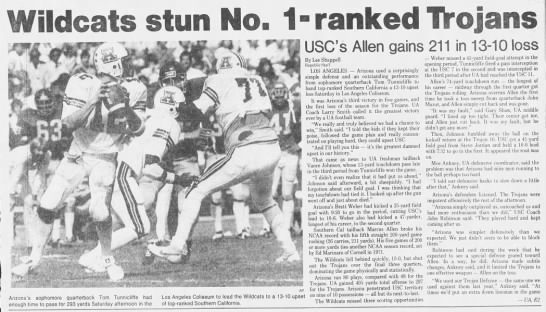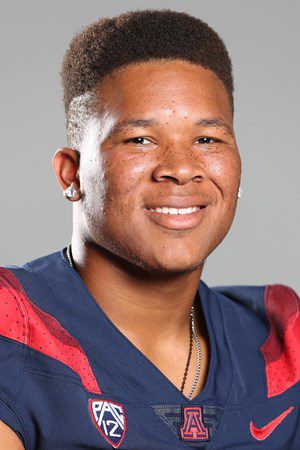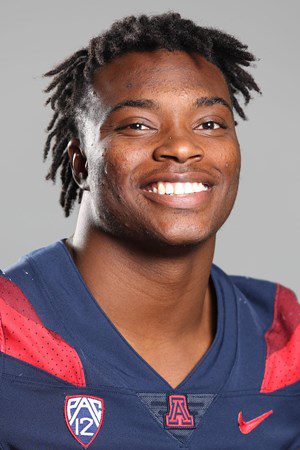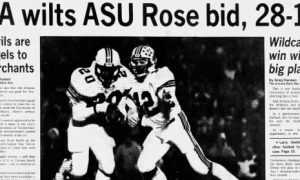We have reached only 11 days until the Arizona Wildcats kick off their 2018 campaign under new coach Kevin Sumlin. The season begins when Arizona hosts BYU on Sept. 1 at Arizona Stadium.
To get ready for the upcoming season, All Sports Tucson offers another countdown, which includes memories from former Wildcats, history notes and a look ahead to the season. Think of it as a way to keep Arizona football on the mind in the summer months leading up to fall camp in early August and then kickoff against the Cougars marking the start of the Sumlin Era.

The season marks some substantial anniversaries. It is the 40th anniversary since the Wildcats left the WAC to join the Pac-12 (went from the Pac-8 to the Pac-10 then) and also the 20th anniversary of the 1998 team with the best record in school history, 12-1, and the 25th anniversary of the 1993 team that went 10-2 with a win over Miami in the Fiesta Bowl.
To catch up on the countdown — which included in-depth analysis and reader polls on The Great Debate of which team was better — 1993 or 1998 — click on this: Arizona Wildcats 2018 countdown to kickoff.
Top 25 developments in Pac-10/12 era
Over the last part of the countdown we are ranking the top 25 developments of Arizona’s Pac-10/12 existence that started in 1978 when it arrived with ASU from the WAC. The ranking will include player highlights, team accomplishments, coaching moves and other off-field developments. If a player is involved, the ranking includes happenings only during the course of that athlete’s time at Arizona.
The ranking up to now:
No. 25: Darryll Lewis’ 1990 season
No. 24: Chris McAlister’s career
No. 21: Scooby Wright III’s 2014 season
No. 20: Rich Rodriguez’s tenure
No. 19: Win over No. 1 Washington in 1992
No. 18: John Mackovic coaching fiasco
No. 17: Arizona Stadium upgrades
No. 16: Win at Notre Dame in 1982
No. 15: The Khalil Tate phenomenon
No. 13: Ka’Deem Carey’s rushing exploits
No. 11
Win at No. 1 USC in 1981
Arizona coach Larry Smith placed his thumb and forefinger an inch apart while standing before his Wildcats in practice leading up to the Wildcats’ first game in school history against a No. 1-ranked team.
“There’s just that much difference between the No. 1 team and, say, the No. 56 team,” Smith told them.
Historically, the gap was as wide as the Grand Canyon between Arizona and USC when they faced each other in 1981.

Arizona Daily Star clipping of Arizona’s upset of No. 1 USC in Los Angeles in 1981.
The Wildcats, in only their fourth year in the Pac-10, traveled to Los Angeles to face No. 1 USC, a school it had never beaten in nine tries. The Trojans by that time had won nine national titles and eight Rose Bowls. The Wildcats, 24-point underdogs, lost 34-7 to USC in their previous trip to Los Angeles in 1979. Arizona was 0-7 there, with most of the games taking place in the 1920s.
The Trojans, featuring Heisman Trophy candidate Marcus Allen and All-American defensive back Ronnie Lott, was on a 22-game unbeaten streak at the L.A. Coliseum going back to 1977. They were on a 37-3-2 stretch over a four-year period. Arizona did not win more than six games in a season in the same four-year period.
The Wildcats were 2-2, having played their first four games at home. USC was 4-0 and ranked No. 1 in the country with wins over Tennessee and Oklahoma at the Coliseum.
Despite all the odds against them, the Wildcats believed in their opportunity because of how the late Smith, who passed away in 2008, motivated them.
“I remember Coach Smith saying, ‘Sixty men together on the same page can’t lose,’” Julius Holt, a junior defensive tackle in 1981, told me.
Holt danced about and yelled loud enough for everyone to hear near the Arizona locker room after the upset: “We came to play! They came to sleep!”
Randy Robbins, a defensive back who played nine years in the NFL, told me that Arizona used its underdog role and inexperience in such contests to their benefit.
“Sixty men together can’t lose”
Julius Holt is shown in celebration on the front page of the Tucson Citizen after Arizona’s upset win over No. 1 USC in 1981
“I remember everyone — media, etc. — saying for the week was how invincible USC was compared to everyone they had played so far to date,” Robbins said. “As players, we were such a young group as a whole. We were kind of oblivious as to what the stakes were about this game.
“We felt that no one was giving us a chance in this game. However, as players we were not afraid or not intimidated by USC. They were going to get our best effort as players. (That’s) what we decided as a team.”
Arizona’s will was tested early as the Trojans took a 10-0 lead after less than eight minutes. Allen broke off a student-body-right play for 74 yards for the first score and Steve Jordan kicked a 21-yard field goal.
“We were a bit shaken (after Allen’s touchdown run),” Mark Walczak, a tight end with the Wildcats, told me. “But our defense got tough and and the offense made things happen.
“By half we knew we knew that we could beat them if we played hard and mistake-free and we did.”
Two Brett Weber field goals, one a 47-yarder 30 seconds before halftime and a 25-yarder in the third quarter, cut the lead to 10-6. On Arizona’s last offensive play of the third quarter, sophomore quarterback Tom Tunnicliffe, from nearby Burbank, Calif., hit freshman tailback Vance Johnson with a 13-yard touchdown pass that put the Wildcats ahead for good.
“John Robinson came into our locker room after the game to personally congratulate each player and coach. It was a very special experience.” — Jeff Kiewel, Arizona junior offensive tackle in 1981

Jeff Kiewel was an Arizona offensive lineman who had a key block on a late possession by the Wildcats at No. 1 USC in 1981
The Wildcats pulled off their most significant upset in the greatest game in school history thanks to Tunnicliffe’s 293 yards passing and a defense that yielded only 297 yards in total offense, 186 yards under the mighty Trojans’ average.
Allen ran for 211 yards in 26 carries and extended his NCAA record of consecutive 200-yard rushing games to five, but the other Trojans were nowhere to be found. The rest of the running backs gained only 26 yards and USC passed for only 60 yards. Arizona outgained USC 405-297 in total yards.
The Wildcats’ defense, led by College Hall of Fame inductee Ricky Hunley, Robbins and Holt, limited USC’s offense to only nine plays in the third period and 15 in the fourth. The Trojans crossed midfield only once in the second half. They fumbled on the first play after crossing the 50-yard line.
“Arizona deserved to win and they outplayed us in every phase of the game,” USC coach John Robinson was quoted as saying by the Los Angeles Times. “They also outcoached us. We played inconsistently and coached inconsistently. You have to give Arizona credit. They just kept coming at us.”
Robinson was so impressed he visited Smith and the Wildcats in their locker room after the game to congratulate them.
Steve Grimley, who covered the game for the Orange County (Calif.) Register, delivered a paragraph in his report that deserves repeating:
The difference was Tunnicliffe, who defied the rules of football logic and played ball-control offense with the forward pass. Throwing in the shadow of a huge, purple stage erected for this weekend’s Rolling Stones concerts in the Coliseum, he definitely had the Trojan secondary under his thumb.
Grimley also offered a quote to remember from Arizona offensive lineman Frank Kalil:
Kalil, the 245-pound Wildcat left guard out of Servite High, agreed that the Trojans seemed unprepared for a passing attack. “‘All their linemen try to do is overpower you. They think that’s all they have to do,” he said. “Well, not everyone is Oregon State. They’re not big enough just to run over everyone. Hey, I can press 500 pounds. You can’t just run over me.”

Arizona Republic clipping of Arizona’s win over Marcus Allen and top-ranked USC in 1981.
Tunnicliffe was also instrumental coming off the bench in Arizona’s upset over No. 2 UCLA the previous season in Tucson when it appeared the Bruins would become the No. 1 team in the nation because of top-ranked Alabama’s loss earlier that day.
“Tunnicliffe just seemed to get hot,” Jay Dobyns, a freshman receiver with the Cats in 1981, told me about the quarterback’s performance against USC. “Brad Anderson, Mark Keel and Kevin Ward were making big catches and you could feel it. Tom always played great against the L.A. schools.”
Tunnicliffe, nicknamed Tom “Terrific” during his UA days from 1980-1983, ranks third at Arizona in career passing yards with 7,618. He was atop that list until Willie Tuitama passed for 9,211 between 2005-2008. Nick Foles (2009-2011) now holds the record with 10,011.

Tom Tunnicliffe, pictured here on the cover of a 1981 program, embodied the characteristics of the Arizona football program, fighting for respectability
USC’s vaunted defense that included Lott, cornerback Joey Browner and linebackers Chip Banks and Jack Del Rio only sacked Tunnicliffe once. Smith pointed out to the media after the game the sack occurred only because Arizona had just 10 players on the field.
“Someone is bound to be open if the quarterback has all day to pick out his receivers,” Browner is quoted as saying by the Los Angeles Times.
Tunnicliffe, who played at 6-foot and 200 pounds, was not drafted and signed by an NFL team because of his height, but his resolve stood tall in some of Arizona’s biggest victories against USC, UCLA, ASU and Notre Dame. He is as identifiable in Arizona’s most significant victories in school history as anybody. Max Zendejas and Chuck Cecil are right up there with him.
“The things I use the most are perseverance and optimism,” Tunnicliffe told The Los Angeles Times in a 1991 article. “As bad as things get, they can be turned around. If you have the discipline to do the fundamentals and stay your course, good things will happen.”
The Arizona football program is Tunnicliffe in microcosm. Long considered below the top rung of Pac-12 programs because of their inability to earn a Rose Bowl berth, the Wildcats continue to persevere and remain optimistic through all the changes in coaches, players and schemes.
Arizona’s win over USC in 1981 put the Wildcats on the regional map as the Wildcats turned the page from their WAC days. The upset enhanced the Wildcats’ image in southern California, impacting recruiting and the public perception of Arizona. The days in which Arizona was confused with Arizona State became fewer with such important victories under Smith.
“When you stand your ground, and go toe to toe with the best, and succeed it is always the time that a teams feels at its best,” Walczak said.
The best to wear No. 11 …
The best to wear No. 11 in Arizona history? That honor goes to legendary cornerback Chris McAlister, whose storied career made No. 24 in our Top 25 ranking of developments since Arizona joined the Pac-10/12 in 1978. The cornerback from 1996 to 1998 had these lists of accomplishment other than being a unanimous All-American in 1998: Third-team All-American by the Sporting News in 1997, won the 1998 Mosi Tatupu Award as the nation’s top special-teams player and was a first-team All-Pac-10 player in each of his three seasons at Arizona. The phrase “He shut down half the field” was never more appropriate than when uttered about McAlister. He intercepted 18 passes in his three seasons at Arizona (third-best in school history).
Wearing No. 11 now …
Two players wear No. 11 now and they hail from SEC country — redshirt freshman quarterback K’Hari Lane of Macon County (Ga.) High School and sophomore safety Troy Young from Prichard (Ala.) Mobile Christian.

K’Hari Lane
Lane led his Macon County team to a 12-2 record and a state championship as a senior. He threw for 3,740 yards, 56 touchdowns and just two interceptions his senior year. He is majoring in journalism, so he is a potential sports journalist down the road.

Troy Young
Young played in all 13 games as a true freshman last year with one start at safety (at California). He totaled five tackles with a pass breakup as a true freshman and collected a season-high three tackles – all solo stops – against Purdue in the Foster Farms Bowl.
FOLLOW @JAVIERJMORALES ON TWITTER!
ALLSPORTSTUCSON.com publisher, writer and editor Javier Morales is a former Arizona Press Club award winner. He is a former Arizona Daily Star beat reporter for the Arizona basketball team, including when the Wildcats won the 1996-97 NCAA title. He has also written articles for CollegeAD.com, Bleacher Report, Lindy’s Sports, TucsonCitizen.com, The Arizona Republic, Sporting News and Baseball America, among many other publications. He has also authored the book “The Highest Form of Living”, which is available at Amazon.



















